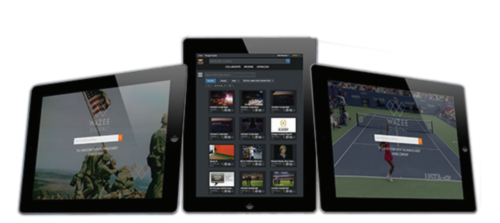Connections

M&E Journal: Employ a ‘Make Once/Use Any’ Strategy to Get the Most Out of Your Content
Story Highlights
By Andy Hurt, SVP of Marketing and Business Development, Wazee Digital –
In today’s world of M&E, an almost immeasurable amount of high-value content is being created every day. Think of it. Movie and television studios are sitting on iconic titles and clips that help define a culture. News broadcasters have video in their archives depicting pivotal moments in history. In the world of sports and live events, content owners and rights holders are constantly recording plenty of once-in-a-lifetime, available-nowhere-else footage.
Beyond its original purpose, all that content is ripe for reuse minutes or decades later. Maybe it’s pushing highlights through social media channels during and after a sports broadcast. Maybe it’s licensing TV programs or movies for paid OTT or VOD use.
Maybe it’s selling clips to advertising agencies, documentarians, or other broadcasters to use in their projects. Whatever the case, there are plenty of ways to reuse media content and plenty of people willing to pay to do so … which means there is plenty of opportunity for content owners to turn their archives into continuous revenue generators.
To maximize the opportunity for reuse and monetization, content owners and rights holders would do well to take a “make once/use any” approach to media management. Make once/use any is the notion of creating and ingesting master content one time into a central location, and then accessing it anytime from anywhere through multiple workflows for unlimited use and reuse. The goal is to create and capture high-quality content once and make it available as many times and in as many ways/applications as you want in perpetuity.
The best way to achieve this make once/use any strategy is by creating “smart” content, and that means you need a truly smart content-management system, one that makes content easily discoverable, accessible and licensable while minimizing the expense and effort of storing it, transcoding it and delivering it. A smart content- management system has the intelligence to generate granular metadata, store and restore content with security and ease, transform the data into the appropriate format for any deliverable, and even manage the rights and clearances for the content.
The elements of a make once/ use any system
Make once/use any depends on storage and computing in the cloud.
Cloud storage — Traditional archives and MAM systems store content behind a firewall, likely on LTO tape, where it is inaccessible to anyone outside your organization (i.e., the ones who might want to buy it). Therefore, the first step is to store your assets in a cloud-based platform, where they are more easily searchable and distributable according to strict security policies.
Putting content in the cloud might seem counterintuitive, but it’s the key to successful reuse and monetization – and it’s more secure. Why? Because sharing content outside the firewall, in a less risky and security-focused environment means the right people will be able to discover it and the wrong people won’t attack it. Even better, a cloud-based MAM application that is also tied to licensing will turn what was once just a storage expense into revenue.
Enriched metadata — Another crucial element of a make once/use any system is metadata. Rich metadata is the key to content discovery and monetization. It powers advanced video search and recommendation engines that lie at the heart of buying and viewing decisions. By creating and managing both asset-level and time-based metadata at the production stage, content owners can add greater value to the life of their video content.
Most assets enter an archive with a full load of technical metadata and sometimes even basic descriptive metadata, but that metadata isn’t enough for monetization. The ideal system is smart enough to automatically extract a wide range of asset-level and time-based metadata detail from the content itself during ingest. Once in the cloud, enriched metadata makes otherwise stagnant or lost assets searchable, discoverable, and shareable.
Smart asset management — The best cloud-enabled MAM systems are built not just for management, but for monetization. Putting the right software in place makes it easy to build a specific workflow for any given request — a workflow that includes finding and tagging assets, creating clips, and making those clips accessible to third parties. These cloud-based systems are backed by software that makes for highly sophisticated cloud computing and smart workflows.
 It is this built-in intelligence that enables, for example, transcoding workflows that take clips from the highest-quality master and transform them for any digital endpoint — satellite, cable, OTT, VOD, social media, or even sales and marketing vehicles (trailers, ads, poster art, one sheets, press kit photography, etc.).
It is this built-in intelligence that enables, for example, transcoding workflows that take clips from the highest-quality master and transform them for any digital endpoint — satellite, cable, OTT, VOD, social media, or even sales and marketing vehicles (trailers, ads, poster art, one sheets, press kit photography, etc.).
Among their many benefits, cloud-based storage and asset management systems offer the speed and flexibility needed in today’s video-distribution landscape, where VOD, OTT, social media and 24-hour news applications call for immediate and easy access to a well-organized catalog of video — in both digital and broadcast quality, with the ability to accommodate any end device, from smartphones to HDTVs and beyond.
That’s because they allow anyone with credentials to search the archive and preview and download clips from the cloud within minutes of making a selection. By contrast, filling content requests with traditional archives means people must dig through a vault full of often poorly organized physical tapes in hopes of finding a specific clip, a time-consuming process that isn’t always successful.
Wrapping up
Major studios, governmental departments, broadcasters, sports federations, news archives and a wide range of other content owners and rights holders around the world have put the make once/use any strategy to work for them. Those organizations knew that asset management was just the beginning, and that putting a smart content management system in place would help make those assets well preserved, searchable, accessible and, in many cases, monetizable.
Wazee Digital Core, the company’s cloud-native media asset management system, embodies the make once/use any concept. Core was built from the ground up to operate in the cloud, which enables all sorts of advantages when it comes to finding, sharing, and monetizing content.
Core powers access to transcripts and interviews and includes advanced metadata-enrichment capabilities, all of which help people quickly find specific moments within a show. Core also drives the underlying search experience, which enables online search portals with granular layers of access.
The ultimate benefit is that content owners can create content once and then use and reuse it in nearly infinite ways, anywhere, in any format.
—-
Click here to translate this article
Click here to download the complete .PDF version of this article
Click here to download the entire Winter 2018 M&E Journal









